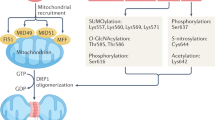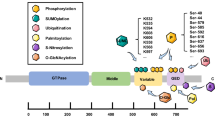Abstract
Mitochondrial dysfunction has been implicated in various types of cardiovascular disease including hypertension. Mitochondrial fission fusion balance is critical to mitochondrial quality control, whereas enhanced fission has been reported in several models of cardiovascular disease. However, limited information is available regarding the contribution of mitochondrial fission in hypertension. Here, we have tested the hypothesis that inhibition of mitochondrial fission attenuates the development of hypertension and associated vascular remodeling. In C57BL6 mice infused with angiotensin II for 2 weeks, co-treatment of mitochondrial fission inhibitor, mdivi1, significantly inhibited angiotensin II-induced development of hypertension assessed by radiotelemetry. Histological assessment of hearts and aortas showed that mdivi1 inhibited vessel fibrosis and hypertrophy induced by angiotensin II. This was associated with attenuation of angiotensin II-induced decline in mitochondrial aspect ratio seen in both the endothelial and medial layers of aortas. Mdivi1 also mitigated angiotensin II-induced cardiac hypertrophy assessed by heart weight-to-body weight ratio as well as by echocardiography. In ex vivo experiments, mdivi1 inhibited vasoconstriction and abolished the enhanced vascular reactivity by angiotensin II in small mesenteric arteries. Proteomic analysis on endothelial cell culture media with angiotensin II and/or mdivi1 treatment revealed that mdivi1 inhibited endothelial cell hypersecretory phenotype induced by angiotensin II. In addition, mdivi1 attenuated angiotensin II-induced protein induction of periostin, a myofibroblast marker in cultured vascular fibroblasts. In conclusion, these data suggest that mdivi1 prevented angiotensin II-induced hypertension and cardiovascular remodeling via multicellular mechanisms in the vasculature.







Similar content being viewed by others
References
Picard M, Wallace DC, Burelle Y. The rise of mitochondria in medicine. Mitochondrion. 2016;30:105–16.
Mishra P, Chan DC. Metabolic regulation of mitochondrial dynamics. J Cell Biol. 2016;212:379–87.
Kraus F, Roy K, Pucadyil TJ, Ryan MT. Function and regulation of the divisome for mitochondrial fission. Nature. 2021;590:57–66.
Vasquez-Trincado C, Garcia-Carvajal I, Pennanen C, Parra V, Hill JA, Rothermel BA, et al. Mitochondrial dynamics, mitophagy and cardiovascular disease. J Physiol. 2016;594:509–25.
Kirkman DL, Robinson AT, Rossman MJ, Seals DR, Edwards DG. Mitochondrial contributions to vascular endothelial dysfunction, arterial stiffness, and cardiovascular diseases. Am J Physiol Heart Circ Physiol. 2021;320:H2080–H2100.
Cicalese SM, da Silva JF, Priviero F, Webb RC, Eguchi S, Tostes RC. Vascular stress signaling in hypertension. Circ Res. 2021;128:969–92.
Forrester SJ, Booz GW, Sigmund CD, Coffman TM, Kawai T, Rizzo V, et al. Angiotensin II signal transduction: an update on mechanisms of physiology and pathophysiology. Physiol Rev. 2018;98:1627–738.
Brown IAM, Diederich L, Good ME, DeLalio LJ, Murphy SA, Cortese-Krott MM, et al. Vascular smooth muscle remodeling in conductive and resistance arteries in hypertension. Arterioscler Thromb Vasc Biol. 2018;38:1969–85.
Humphrey JD. Mechanisms of vascular remodeling in hypertension. Am J Hypertens. 2021;34:432–41.
Jia G, Aroor AR, Hill MA, Sowers JR. Role of renin-angiotensin-aldosterone system activation in promoting cardiovascular fibrosis and stiffness. Hypertension. 2018;72:537–48.
Takayanagi T, Forrester SJ, Kawai T, Obama T, Tsuji T, Elliott KJ, et al. Vascular ADAM17 as a novel therapeutic target in mediating cardiovascular hypertrophy and perivascular fibrosis induced by angiotensin II. Hypertension. 2016;68:949–55.
Takayanagi T, Kawai T, Forrester SJ, Obama T, Tsuji T, Fukuda Y, et al. Role of epidermal growth factor receptor and endoplasmic reticulum stress in vascular remodeling induced by angiotensin II. Hypertension. 2015;65:1349–55.
Lim S, Lee SY, Seo HH, Ham O, Lee C, Park JH, et al. Regulation of mitochondrial morphology by positive feedback interaction between PKCdelta and Drp1 in vascular smooth muscle cell. J Cell Biochem. 2015;116:648–60.
Cooper HA, Cicalese S, Preston KJ, Kawai T, Okuno K, Choi ET, et al. Targeting mitochondrial fission as a potential therapeutic for abdominal aortic aneurysm. Cardiovasc Res. 2021;117:971–82.
Takayanagi T, Crawford KJ, Kobayashi T, Obama T, Tsuji T, Elliott KJ, et al. Caveolin 1 is critical for abdominal aortic aneurysm formation induced by angiotensin II and inhibition of lysyl oxidase. Clin Sci (Lond). 2014;126:785–94.
Osei-Owusu P, Sabharwal R, Kaltenbronn KM, Rhee MH, Chapleau MW, Dietrich HH, et al. Regulator of G protein signaling 2 deficiency causes endothelial dysfunction and impaired endothelium-derived hyperpolarizing factor-mediated relaxation by dysregulating Gi/o signaling. J Biol Chem. 2012;287:12541–9.
Osei-Owusu P, Knutsen RH, Kozel BA, Dietrich HH, Blumer KJ, Mecham RP. Altered reactivity of resistance vasculature contributes to hypertension in elastin insufficiency. Am J Physiol Heart Circ Physiol. 2014;306:H654–666.
Torimoto K, Okuno K, Kuroda R, Shanas N, Cicalese SM, Eguchi K, et al. Glucose consumption of vascular cell types in culture: toward optimization of experimental conditions. Am J Physiol Cell Physiol. 2022;322:C73–C85.
Asano T, Nakamura H, Kawamoto Y, Tada M, Kimura Y, Takano H, et al. Inhibition of Crmp1 phosphorylation at Ser522 ameliorates motor function and neuronal pathology in amyotrophic lateral sclerosis model mice. eNeuro. 2022;9:ENEURO.0133–22.2022.
Elliott KJ, Eguchi S. In vitro analysis of hypertensive signal transduction: kinase activation, kinase manipulation, and physiologic outputs. Methods Mol Biol (Clifton, NJ). 2017;1527:201–11.
Forrester SJ, Preston KJ, Cooper HA, Boyer MJ, Escoto KM, Poltronetti AJ, et al. Mitochondrial fission mediates endothelial inflammation. Hypertension. 2020;76:267–76.
Miyao M, Cicalese S, Kawai T, Cooper HA, Boyer MJ, Elliott KJ, et al. Involvement of senescence and mitochondrial fission in endothelial cell pro-inflammatory phenotype induced by angiotensin II. Int J Mol Sci. 2020;21:3112.
Dagamajalu S, Rex DAB, Palollathil A, Shetty R, Bhat G, Cheung LWT, et al. A pathway map of AXL receptor-mediated signaling network. J Cell Commun Signal. 2021;15:143–8.
Deng Y, Li S, Chen Z, Wang W, Geng B, Cai J. Mdivi-1, a mitochondrial fission inhibitor, reduces angiotensin-II- induced hypertension by mediating VSMC phenotypic switch. Biomed Pharmacother. 2021;140:111689.
Liu MY, Jin J, Li SL, Yan J, Zhen CL, Gao JL, et al. Mitochondrial fission of smooth muscle cells is involved in artery constriction. Hypertension. 2016;68:1245–54.
Jeon KI, Kumar A, Wozniak KT, Nehrke K, Huxlin KR. Defining the role of mitochondrial fission in corneal myofibroblast differentiation. Invest Ophthalmol Vis Sci. 2022;63:2.
Cha Y, Kim T, Jeon J, Jang Y, Kim PB, Lopes C, et al. SIRT2 regulates mitochondrial dynamics and reprogramming via MEK1-ERK-DRP1 and AKT1-DRP1 axes. Cell Rep. 2021;37:110155.
Lombardi AA, Gibb AA, Arif E, Kolmetzky DW, Tomar D, Luongo TS, et al. Mitochondrial calcium exchange links metabolism with the epigenome to control cellular differentiation. Nat Commun. 2019;10:4509.
Kanisicak O, Khalil H, Ivey MJ, Karch J, Maliken BD, Correll RN, et al. Genetic lineage tracing defines myofibroblast origin and function in the injured heart. Nat Commun. 2016;7:12260.
Wang Y, Lu M, Xiong L, Fan J, Zhou Y, Li H, et al. Drp1-mediated mitochondrial fission promotes renal fibroblast activation and fibrogenesis. Cell Death Dis. 2020;11:29.
Lautrette A, Li S, Alili R, Sunnarborg SW, Burtin M, Lee DC, et al. Angiotensin II and EGF receptor cross-talk in chronic kidney diseases: a new therapeutic approach. Nat Med. 2005;11:867–74.
Ikeda Y, Shirakabe A, Maejima Y, Zhai P, Sciarretta S, Toli J, et al. Endogenous Drp1 mediates mitochondrial autophagy and protects the heart against energy stress. Circ Res. 2015;116:264–78.
Okuno K, Torimoto K, Cicalese SM, Preston K, Rizzo V, Hashimoto T, et al. Angiotensin II type 1A receptor expressed in smooth muscle cells is required for hypertensive vascular remodeling in mice infused with angiotensin II. Hypertension. 2023;80:668–77.
Eguchi S, Sparks MA, Sawada H, Lu HS, Daugherty A, Zhuo JL. Recent advances in understanding the molecular pathophysiology of angiotensin II receptors: lessons from cell-selective receptor deletion in mice. Can J Cardiol. 2023;39:1795–807.
Xu Z, Ding J, Zhang L, Feng X, Zhou J, Shen X, et al. Peptidomics analysis revealed that a novel peptide VMP‑19 protects against Ang II‑induced injury in human umbilical vein endothelial cells. Mol Med Rep. 2021;23:298.
Gao BB, Stuart L, Feener EP. Label-free quantitative analysis of one-dimensional PAGE LC/MS/MS proteome: application on angiotensin II-stimulated smooth muscle cells secretome. Mol Cell Proteom. 2008;7:2399–409.
Dihazi GH, Eltoweissy M, Jahn O, Tampe B, Zeisberg M, Wulfrath HS, et al. The secretome analysis of activated human renal fibroblasts revealed beneficial effect of the modulation of the secreted peptidyl-prolyl cis-trans isomerase A in kidney fibrosis. Cells. 2020;9:1724.
Weisberg AD, Albornoz F, Griffin JP, Crandall DL, Elokdah H, Fogo AB, et al. Pharmacological inhibition and genetic deficiency of plasminogen activator inhibitor-1 attenuates angiotensin II/salt-induced aortic remodeling. Arterioscler Thromb Vasc Biol. 2005;25:365–71.
Smith G, Gallo G. To mdivi-1 or not to mdivi-1: Is that the question? Dev Neurobiol. 2017;77:1260–8.
Bordt EA, Clerc P, Roelofs BA, Saladino AJ, Tretter L, Adam-Vizi V, et al. The putative Drp1 inhibitor mdivi-1 is a reversible mitochondrial complex I inhibitor that modulates reactive oxygen species. Dev Cell. 2017;40:583–94 e586.
Acknowledgements
We thank Dr. Katherine J Elliott for critical comments.
Funding
This work was supported by the National Institutes of Health Grants (RO1 NS109382 and RO1 AG077780 to TH and SE, and R56 DK132859 to PO-O).
Author information
Authors and Affiliations
Corresponding author
Ethics declarations
Conflict of interest
The authors declare no competing interests.
Additional information
Publisher’s note Springer Nature remains neutral with regard to jurisdictional claims in published maps and institutional affiliations.
Supplementary Information
Rights and permissions
Springer Nature or its licensor (e.g. a society or other partner) holds exclusive rights to this article under a publishing agreement with the author(s) or other rightsholder(s); author self-archiving of the accepted manuscript version of this article is solely governed by the terms of such publishing agreement and applicable law.
About this article
Cite this article
Preston, K.J., Kawai, T., Torimoto, K. et al. Mitochondrial fission inhibition protects against hypertension induced by angiotensin II. Hypertens Res 47, 1338–1349 (2024). https://doi.org/10.1038/s41440-024-01610-0
Received:
Revised:
Accepted:
Published:
Issue Date:
DOI: https://doi.org/10.1038/s41440-024-01610-0
- Springer Nature Singapore Pte Ltd.
Keywords
This article is cited by
-
Mitochondrial fission: a new mechanism of hypertension and cardiovascular remodeling induced by Angiotensin II
Hypertension Research (2024)




